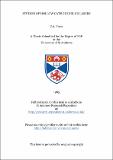Studies of hollow cathode He-Cd lasers
Abstract
Novel segmented-electrode discharge tubes which operate as sealed-off He-Cd hollow cathode lasers and which do not require a flowing gas system to distribute cadmium vapour are reported. The electrode geometry is arranged to produce a net axial electric field so that cadmium distribution is enhanced by cataphoresis,' a process which is not normally associated with He-Cd hollow cathode lasers. The conditions under which the segmented-electrode tubes exhibit the properties of hollow cathode discharges are determined from their current and voltage characteristics. One system studied consists of alternate anode and cathode segments with glass insulating sections arranged axially, and behaves as a series of hollow cathode discharges under appropriate conditions. Each anode/hollow cathode pair is separated from its neighbouring segments by insulating glass sections of length D, which provide a recombination site and prevent adjacent discharges from overlapping each other. A calculation shows that adjacent discharges will remain isolated provided that D> 2.85cm, in helium at 10 Torr and 700 K. Another segmented-electrode system studied consists of a series of metal segments equal in length. This system does not have discrete anode segments and exhibits the positive Volt-Ampere (VI) characteristics normally expected of, hollow cathode discharges only at low values of discharge current. A transition point in the characteristics exists, and, for discharge currents above this, the VI slope is negative. This behaviour is explained in terms of the plasma length, which is defined as the axial extent of the negative glow within a cylindrical segment, and which increases with increasing discharge current. At low values of discharge current (several mA), the plasma length is less than the length of the metal segments, and the discharge tube operates as a series of hollow cathodes. Under these conditions, each segment has a negative glow discharge partially penetrating the bore from one end, while the other end performs as an anode for the next segment, and so on. The last segment is at power supply earth potential and has no anodic function. The transition points in the VI characteristics occur when the discharge current is increased to a value such that the plasma length equals the length of the metal segments. For discharge currents above this value, only the last segment at power supply earth potential continues to operate as a hollow cathode. The results of these studies provide guidelines for the design of segmented-electrode He-Cd hollow cathode laser discharge tubes in terms of the axial order and optimum spacing of anode and cathode segments. It is shown that large axial temperature variations can exist in thin-walled (0.9mm) hollow cathode structures, implying that the current density distribution at the cathode surface is not uniform. A differential equation is derived to describe heat flow within a cylindrical conductor heated at one end and cooled by natural convection and radiation along its length. Approximate solutions are obtained for both thick-walled and thin-walled conductors. The results of the thick-walled approximation yield thermal design criteria for hollow cathodes, where moderate cathode temperatures (350°C) and minimal axial temperature variations are required. The thin-walled approximation yields results which provide design criteria for the protection from high temperature failure of components such as cylindrical glass/metal seals and 'O' rings. (Abstract shortened by ProQuest.)
Type
Thesis, PhD Doctor of Philosophy
Collections
Items in the St Andrews Research Repository are protected by copyright, with all rights reserved, unless otherwise indicated.

